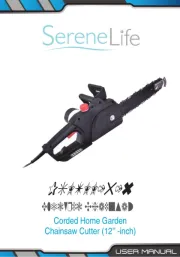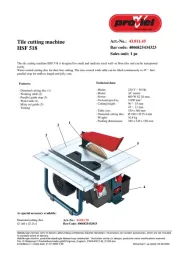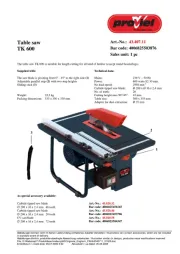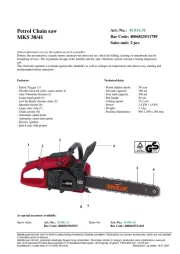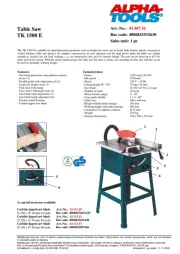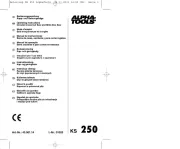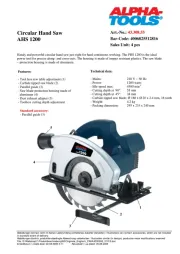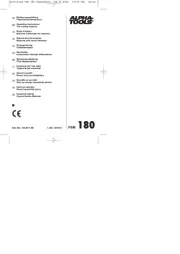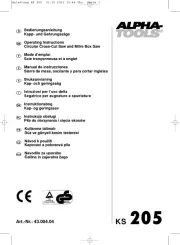• Check for misalignment or binding of moving parts, breakage of parts, and any other
condition that may affect the tool’s operation. If damaged, have the tool serviced
before using. Many accidents are caused by poorly maintained tools.
• Use only accessories that are recommended by the manufacturer for your model.
Accessories that may be suitable for one tool may create a risk of injury when used on
another tool.
Service
• Tool service must be performed only by qualified repair personnel. Service or
maintenance performed by unqualified personnel may result in a risk of injury.
• When servicing a tool, use only identical replacement parts. Follow instructions in
the Maintenance section of this manual. Use of unauthorized parts or failure to follow
Maintenance Instructions may create a risk of shock or injury.
Specific Safety Rules
DANGER: Keep hands away from cutting area and blade. Keep your second hand
on auxiliary handle, or motor housing. If both hands are holding the saw, they cannot be
cut by the blade.
•Keep your body positioned to either side of the saw blade, but not in line with the
saw blade. KICKBACK could cause the saw to jump backwards. (See "Causes and
Operator Prevention of Kickback").
•Do not reach underneath the work. The guard cannot protect you from the blade below
the work.
•Check lower guard for proper closing before each use. Do not operate saw if lower
guard does not move freely and close instantly. Never clamp or tie the lower guard
into the open position. If saw is accidentally dropped, lower guard may be bent. Raise the
lower guard with the Retracting Lever and make sure it moves freely and does not touch the
blade or any other part, in all angles and depths of cut.
•Check the operation and condition of the lower guard spring. If the guard and the
spring are not operating properly, they must be serviced before use. Lower guard
may operate sluggishly due to damaged parts, gummy deposits, or a buildup of debris.
•Lower guard should be retracted manually only for special cuts such as "Pocket
Cuts" and "Compound Cuts". Raise the lower guard by Retracting Lever. As soon as
blade enters the material, lower guard must be released. For all other sawing, the lower
guard should operate automatically.
•Always observe that the lower guard is covering the blade before placing saw down
on bench or floor. An unprotected, coasting blade will cause the saw to walk backwards,
cutting whatever is in its path. Be aware of the time it takes for the blade to stop after switch
is released.
• NEVER hold piece being cut in your hands or across your leg. It is important to support
the work properly to minimize body exposure, blade binding, or loss of control.
• Hold tool by insulated gripping surfaces when performing an operation where the
cutting tool may contact hidden wiring. Contact with a “live” wire will also make exposed
metal parts of the tool "live" and shock the operator.
• When ripping, always use a rip fence or straight edge guide. This improves the
accuracy of the cut and reduces the chance for blade binding.
• Always use blades with correct size and shape (diamond vs. round) arbor holes.
Blades that do not match the mounting hardware of the saw will run eccentrically, causing
loss of control.
• Never use damaged or incorrect blade washers or bolts. The blade washers and bolt
were specially designed for your saw, for optimum performance and safety of operation.
Causes and Operator Prevention of Kickback
• Kickback is a sudden reaction to a pinched, bound or misaligned saw blade, causing an
uncontrolled saw to lift up and out of the workpiece toward the operator.
• When the blade is pinched or bound tightly by the kerf closing down, the blade stalls and
the motor reaction drives the unit rapidly back toward the operator.
• If the blade becomes twisted or misaligned in the cut, the teeth at the back edge of the
blade can dig into the top surface of the wood causing the blade to climb out of the kerf and
jump back toward the operator.
• Kickback is the result of tool misuse and/or incorrect operating procedures or conditions
and can be avoided by taking proper precautions as given below:
• Maintain a firm grip on the saw and position your body and arm in a way that allows
you to resist KICKBACK forces. KICKBACK forces can be controlled by the operator, if
proper precautions are taken.
• When blade is binding or when interrupting a cut for any reason, release the trigger
and hold the saw motionless in the material until the blade comes to a complete stop.
Never attempt to remove the saw from the work or pull the saw backward while the
blade is in motion or KICKBACK may occur. Investigate and take corrective actions to
eliminate the cause of blade binding.
• When restarting a saw in the workpiece, center the saw blade in the kerf and check
that teeth are not engaged into the material. If saw blade is binding it may walk up or
KICKBACK from the workpiece as the saw is restarted.
•Support large panels to minimize the risk of blade pinching and KICKBACK. Large
panels tend to sag under their own weight. Supports must be placed under the panel on
both sides, near the line of cut and near the edge of the panel.
•Do not use dull or damaged blade. Unsharpened or improperly set blades produce
narrow kerf causing excessive friction, blade binding and KICKBACK.
•Blade depth and bevel adjusting locking levers must be tight and secure before
making cut. If blade adjustment shifts while cutting, it may cause binding and KICKBACK.
•Use extra caution when making a "Pocket Cut" into existing walls or other blind
areas. The protruding blade may cut objects that can cause KICKBACK.
The label on your tool may include the following symbols.
V ..........................volts A..........................amperes
Hz ........................hertz W ........................watts
min........................minutes ......................alternating current
......................direct current no........................no load speed
..........................
Class II Construction ........................earthing terminal
..........................safety alert symbol
.../min ................revolutions or reciprocations per minute
Additional Safety Rules: Circular Saws
WARNING: Some dust created by power sanding, sawing, grinding, drilling, and
other construction activities contains chemicals known to cause cancer, birth
defects or other reproductive harm. Some examples of these chemicals are:
• lead from lead-based paints,
• crystalline silica from bricks and cement and other masonry products, and
• arsenic and chromium from chemically-treated lumber (CCA).
Your risk from these exposures varies, depending on how often you do this type of work. To
reduce your exposure to these chemicals: work in a well ventilated area, and work with
approved safety equipment, such as those dust masks that are specially designed to filter
out microscopic particles.
•Avoid prolonged contact with dust from power sanding, sawing, grinding, drilling,
and other construction activities. Wear protective clothing and wash exposed areas
with soap and water. Allowing dust to get into your mouth, eyes, or lay on the skin may
promote absorption of harmful chemicals.
WARNING: Use of this tool can generate and/or disperse dust, which may cause
serious and permanent respiratory or other injury. Always use NIOSH/OSHA approved
respiratory protection appropriate for the dust exposure. Direct particles away from face and
body.
CAUTION: Wear appropriate hearing protection during use. Under some conditions
and duration of use, noise from this product may contribute to hearing loss.
•Snagging the lower guard on a surface below the material being cut can momentarily
reduce operator control. The saw can lift partially out of the cut increasing the chance of
blade twist. Ensure there is sufficient clearance under the workpiece.
• When necessary to raise lower guard manually, use the retracting lever.
•KEEP THE BLADES CLEAN AND SHARP. Sharp blades minimize stalling and kickback.
The use of dull and/or dirty blades can increase the saw loading causing the operator to
push harder which promotes twisting.
DANGER: KEEP HANDS AWAY FROM CUTTING AREA. Keep hands away from blades.
Never place hands in front of or behind the path of the blade while cutting. Do not reach
underneath work while blade is rotating. Do not attempt to remove cut material when blade
is moving.
•SUPPORT LARGE PANELS. Large panels must be supported as shown (Fig. 1) in this
manual to minimize the risk of blade pinching and kickback. When cutting operation
requires the resting of the saw on the workpiece, the saw shall be rested on the larger
portion and the smaller piece cut off.
•USE ONLY CORRECT BLADES AND BLADE ASSEMBLY COMPONENTS WHEN
MOUNTING BLADES. Do not use blades with incorrect size holes. Never use defective or
incorrect blade washers or bolts. Follow blade assembly procedures.
•ADJUSTMENTS. Before cutting be sure depth and bevel adjustments are tight.
C NAT. NO. CS144, CS180, BDCS1400, BDCS1800 FORM O. 609747-21 (MAY 04)
COPYRIGHT©2004 BLACK & DECKER PRINTED IN HINAC
KEY INFORMATION YOU SHOULD KNOW:
•Carbide blades stay sharp much longer than steel blades. Use a carbide blade
whenever possible.
•Adull blade will cause slow, inefficient cutting.
•Always support work properly. (See illustrations on work support in this manual.)
VEA EL ESPAÑOL EN LA CONTRAPORTADA.
SAVE THIS MANUAL FOR FUTURE REFERENCE.
INSTRUCTIVO DE OPERACIÓN, CENTROS DE SERVICIO Y
PÓLIZA DE GARANTÍA. LÉASE ESTEADVERTENCIA:
INSTRUCTIVO ANTES DE USAR EL PRODUCTO.
CATALOG NUMBER
CS144, CS180,
BDCS1400, BDCS1800
INSTRUCTION
MANUAL
GENERAL SAFETY RULES - FOR ALL BATTERY
OPERATED TOOLS
WARNING: READ AND UNDERSTAND ALL INSTRUCTIONS.
Failure to follow all instructions listed below, may result in electric shock, fire and/or serious
personal injury. SAVE THESE INSTRUCTIONS
Work Area
•Keep your work area clean and well lit. Cluttered benches and dark areas invite accidents.
• Do not operate power tools in explosive atmospheres, such as in the presence of
flammable liquids, gases, or dust. Power tools create sparks which may ignite the dust or
fumes.
• Keep bystanders, children, and visitors away while operating a power tool.
Distractions can cause you to lose control.
Electrical Safety
• Do not abuse the cord. Never use the cord to carry the tool. Keep cord away from
heat, oil, sharp edges or moving parts. Replace damaged cords immediately.
Damaged cords may create a fire.
• A battery operated tool with integral batteries or a separate battery pack must be
recharged only with the specified charger for the battery. A charger that may be
suitable for one type of battery may create a risk of fire when used with another battery.
• Use battery operated tool only with specifically designated battery pack. Use of any
other batteries may create a risk of fire.
Personal Safety
• Stay alert, watch what you are doing and use common sense when operating a power
tool. Do not use tool while tired or under the influence of drugs, alcohol, or
medication. A moment of inattention while operating power tools may result in serious
personal injury,
• Dress properly. Do not wear loose clothing or jewelry. Contain long hair. Keep your
hair, clothing, and gloves away from moving parts. Loose clothes, jewelry, or long hair
can be caught in moving parts.
• Avoid accidental starting. Be sure switch is in the locked or off position before
inserting battery pack. Carrying tools with your finger on the switch or inserting the battery
pack into a tool with the switch on invites accidents.
• Remove adjusting keys or wrenches before turning the tool on. A wrench or a key that
is left attached to a rotating part of the tool may result in personal injury.
• Do not overreach. Keep proper footing and balance at all times. Proper footing and
balance enable better control of the tool in unexpected situations.
• Use safety equipment. Always wear eye protection. Dust mask, non-skid safety shoes,
hard hat, or hearing protection must be used for appropriate conditions.
Tool Use and Care
• Use clamps or other practical way to secure and support the workpiece to a stable
platform. Holding the work by hand or against your body is unstable and may lead to loss of
control.
• Do not force tool. Use the correct tool for your application. The correct tool will do the
job better and safer at the rate for which it is designed.
• Do not use tool if switch does not turn it on or off. A tool that cannot be controlled with
the switch is dangerous and must be repaired.
• Disconnect battery pack from tool or place the switch in the locked or off position
before making any adjustments, changing accessories, or storing the tool. Such
preventive safety measures reduce the risk of starting the tool accidentally.
• Store idle tools out of reach of children and other untrained persons. Tools are
dangerous in the hands of untrained users.
• When battery pack is not in use, keep it away from other metal objects like: paper
clips, coins, keys, nails, screws or other small metal objects that can make a
connection from one terminal to another. Shorting the battery terminals together may
cause sparks, burns, or a fire.
• Maintain tools with care. Keep cutting tools sharp and clean. Properly maintained tools,
with sharp cutting edge are less likely to bind and are easier to control.
BEFORE RETURNING THIS PRODUCT
FOR ANY REASON PLEASE CALL
1-800-54-HOW-TO (544-6986)
IF YOU SHOULD EXPERIENCE APROBLEM
WITH YOUR BLACK & DECKER PRODUCT,
CALL 1-800-54-HOW-TO (544-6986)
BEFORE YOU CALL, HAVE THE FOLLOWING INFORMATION AVAILABLE, CATALOG No.,
TYPE No., AND DATE CODE. IN MOST CASES, A REPRESENTATIVE CANBLACK & DECKER
RESOLVE THE PROBLEM OVER THE PHONE. IF YOU HAVE A SUGGESTION OR COMMENT,
GIVE US A CALL. YOUR FEEDBACK IS VITAL TO BLACK & DECKER.
1
1
1
1
1
1
1
1
1
14
4
4
4
4
4
4
4
4
4
&
&
&
&
&
&
&
&
&
&1
1
1
1
1
1
1
1
1
18
8
8
8
8
8
8
8
8
8
V
V
V
V
V
V
V
V
V
Vo
o
o
o
o
o
o
o
o
ol
l
l
l
l
l
l
l
l
lt
t
t
t
t
t
t
t
t
t
C
C
C
C
C
C
C
C
C
Co
o
o
o
o
o
o
o
o
or
r
r
r
r
r
r
r
r
rd
d
d
d
d
d
d
d
d
dl
l
l
l
l
l
l
l
l
le
e
e
e
e
e
e
e
e
es
s
s
s
s
s
s
s
s
ss
s
s
s
s
s
s
s
s
s
S
S
S
S
S
S
S
S
S
Sa
a
a
a
a
a
a
a
a
aw
w
w
w
w
w
w
w
w
w










